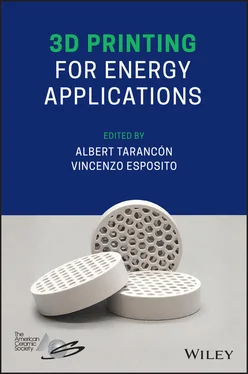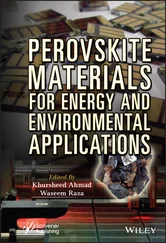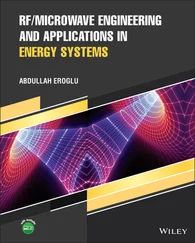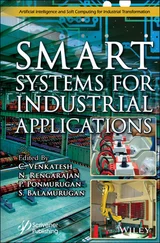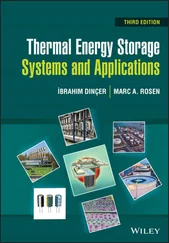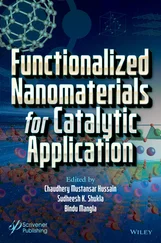1 Cover
2 Title Page
3 Copyright Page
4 Contributors
5 Introduction to 3D Printing Technologies I.1 3D Printing Technologies I.2 3D Printing Hierarchical, Material and Functional Complexity I.3 3D Printing for Energy I.4 Scope of the Book References
6 Part I: 3D printing of functional materials 1 Additive Manufacturing of Functional Metals 1.1 Introduction 1.2 Powder Bed Fusion AM 1.3 Direct Material Deposition 1.4 Solid‐State Additive Manufacturing 1.5 Hybrid AM Through Green Body Sintering 1.6 Conclusions Acknowledgment References 2 Additive Manufacturing of Functional Ceramics 2.1 Introduction 2.2 Ceramics 3D Printing Technologies References 3 3D Printing of Functional Composites with Strain Sensing and Self‐Heating Capabilities 3.1 Introduction 3.2 Carbon Nanotube Reinforced Functional Polymer Nanocomposites 3.3 Printing Strategies 3.4 Strain Sensing of Printed Nanocomposites 3.5 Electric Heating Performance Analysis 3.6 Electrical Actuation of the CNT/SMP Nanocomposites 3.7 Conclusions References
7 Part II: 3D printing challenges for production of complex objects 4 Computational Design of Complex 3D Printed Objects 4.1 Introduction 4.2 Dedicated Computational Design for 3D Printing 4.3 Case Study: Computational Design of a 3D‐Printed Flow Manifold 4.4 Current State and Future Challenges References 5 Multicomponent and Multimaterials Printing 5.1 Multicomponent Printing: A Short Review 5.2 Multicomponent Printing: A Case Study on Piezoceramic Sensors in Smart Pipes 5.3 Summary and Outlook Acknowledgments References 6 Tailoring of AM Component Properties via Laser Powder Bed Fusion 6.1 Introduction 6.2 Machines, Materials, and Sample Preparation 6.3 Sample Preparation and Characterization Techniques 6.4 Material Qualification and Process Development 6.5 Tailoring Grain Size via Adaptive Processing Strategies 6.6 Tailoring Material Properties By Using Powder Blends 6.7 Tailoring Properties By Using Special Geometries Such As Lattice Structures Funding Conflicts of Interest References 7 3D Printing Challenges and New Concepts for Production of Complex Objects 7.1 Introduction 7.2 Geometrical Complexity 7.3 Material Complexity 7.4 Energy Requirements 7.5 Promising Metal Deposition Approaches 7.6 Multimaterial and Multi‐property SLA 7.7 Temporal Multiplexing 7.8 Resin Formulations with Multiple End‐States 7.9 Associated Processing Considerations 7.10 Bioprinting of Realistic and Vascularized Tissue 7.11 Emerging Volumetric Additive Processes 7.12 Computation for CAL 7.13 Material–Process Interactions in CAL 7.14 Current Challenges in CAL 7.15 Expanding the Capabilities of CAL 7.16 Concluding Remarks and Outlook Acknowledgments References
8 Part III: 3D printing of energy devices 8 Current State of 3D Printing Technologies and Materials 8.1 3D Printing of Energy Devices References 9 Capacitors 9.1 Introduction 9.2 Capacitors and Their Current Manufacture 9.3 The Promise of Additive Manufacturing 9.4 Additive Manufacturing Technologies: Considerations for Capacitor Fabrication 9.5 Summary and Outlook References 10 3D‐Printing for Solar Cells 10.1 Introduction 10.2 Examples of 3D‐Printing for PV 10.3 Geometric Light Management 10.4 Conclusions References 11 3D Printing of Fuel Cells and Electrolyzers 11.1 Introduction 11.2 3D Printing of Solid Oxide Cells Technology 11.3 3D Printing of Polymer Exchange Membranes Cells Technology 11.4 3D Printing of Bio‐Fuel Cells Technology 11.5 Conclusions and Outlook References 12 DED for Repair and Manufacture of Turbomachinery Components 12.1 Introduction 12.2 DED Based Repair of Turbomachinery Components 12.3 DED Based Hybrid Manufacturing of New Components 12.4 Summary Acknowledgments References 13 Thermoelectrics 13.1 Introduction 13.2 Additive Manufacturing Techniques of Thermoelectric Materials Acknowledgements References 14 Carbon Capture, Usage, and Storage 14.1 Introduction 14.2 Can 3D Printing Be Used to Fabricate a CO 2Capture Process at Scale? 14.3 A Brief Note on 3D Printing and CO 2at Smaller Scales & Research Efforts 14.4 Conclusions References
9 Index
10 End User License Agreement
1 f04 Table I.1 Functional ceramics processed in the past with additive manufacturi...
2 Chapter 1 Table 1.1 An overview of recently representative work on different types of m... Table 1.2 Overview of functional UAM applications.
3 Chapter 6Table 6.1 Measured relative densities of the chosen set of process parameters...Table 6.2 Nominal chemical compositions and calculated SFE of the investigate...
4 Chapter 9Table 9.1 Summary of capacitor types showing schematics of device architectur...Table 9.2 Functional components in different types of capacitor devices.Table 9.3 Examples of AM technologies, split by process categories, used for ...
5 Chapter 11Table 11.1 List of solid oxide fuel cells reported in the literature includin...
1 f04 Figure I.1 An overview of the basic components and materials used on the mos... Figure I.2 Classification of commercially available additive manufacturing m...
2 Chapter 1 Figure 1.1 Overview of physical and digital links of an AM process chain. Figure 1.2 Schematic overview of functional AM components. Figure 1.3 Working schematic of the L‐PBF equipment, and functionally graded... Figure 1.4 Schematic of powder feedstock based Direct Energy Deposition (DED... Figure 1.5 Schematic of the UAM process. FBG's are high‐temperature optical ... Figure 1.6 Schematic of the hybrid metal AM process chain through sintering....
3 Chapter 2 Figure 2.1 Evolution in number of research articles in materials 3D printing... Figure 2.2 Total market forecast for ceramics additive manufacturing for the... Figure 2.3 Additive manufacturing technologies as a function of the physical... Figure 2.4 Schematic representation of a LOM system. Figure 2.5 Schematic representation of extrusion‐based systems. Figure 2.6 Schematic representation of a photopolymerization‐based 3D printi... Figure 2.7 Schematic representation on a laser‐powder bed system. Figure 2.8 Schematic representation of a jetting‐powder bed system.
4 Chapter 3Figure 3.1 Schematic of a typical (a) thermal jet nozzle setup (b) FDM print...Figure 3.2 Schematic of the digital fabrication of composite strain sensors ...Figure 3.3 Schematic of the digital fabrication of CNT/SMP nanocomposites.Figure 3.4 (a) Optical images of CNT layers printed with 10, 20, 30, 40 cycl...Figure 3.5 (a) Resistance change–strain relationship of composite sensors wi...Figure 3.6 (a) Photographs of the rosette‐type strain sensor attached to tes...Figure 3.7 (a) Left: CNT/SMP composites that have (I) rectangular, (II) hemi...Figure 3.8 (a) Time‐dependent temperature of CS50 composites. (b) Steady‐sta...Figure 3.9 (a) Picture of “L”‐shaped CNT/SMP composites. (b) Snapshots of sh...Figure 3.10 Snapshots of shape recovery process and temperature distribution...
5 Chapter 4Figure 4.1 Topology optimization flowchart. FEA: Finite element analysis, MM...Figure 4.2 Sequence of design evolution of a bracket (selected snapshots). T...Figure 4.3 Overhang angle definition.Figure 4.4 Various overhang angle control approaches. (a) Limits the angle o...Figure 4.5 Overhang angle control approach based on inclusion of a simplifie...Figure 4.6 Conceptual sketches and TO results in case of three design scenar...Figure 4.7 Topology optimization of a pipe bend. (a) Design domain with inle...Figure 4.8 Topology optimization of a pipe bend. (a) Initial geometry. (b) P...Figure 4.9 Topology optimization of a pipe bend with an overhang filter. (a)...Figure 4.10 Topology optimization of a simple manifold. (a) Design domain wi...
6 Chapter 5Figure 5.1 Schematic diagram of EBM technology.Figure 5.2 Setup for fabrication of smart coupling using EPBF AM.Figure 5.3 Exploded (a) and assembled (b) schematic view of the “smart coupl...Figure 5.4 Machined alumina sensor housing used to prevent metallization of ...Figure 5.5 Smart coupling after fabrication of the metallic structure with e...Figure 5.6 Setup of compression–compression test of the smart coupling. An a...Figure 5.7 Schematic of temperature variation experiment on the smart coupli...Figure 5.8 Compression–compression cyclic testing results for three differen...Figure 5.9 Temperature values (a) occurring at the inlet of the smart coupli...Figure 5.10 Temperature comparison between the embedded sensor and the therm...Figure 5.11 XRD plots for the PZT sensor embedded in the smart‐part (darker)...
Читать дальше
